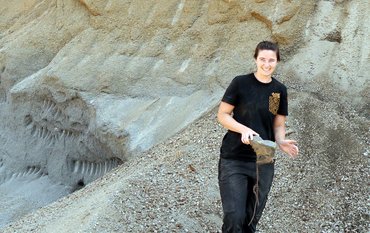04.06.2014: The Canadian Ministry NRCan (Natural Resources Canada) has recently selected the GFZ global-gravity field “EIGEN-6C3” as the basis of the latest Canadian height reference system CGVD2013 (Canadian Geodetic Vertical Datum of 2013). This is a very special tribute to the work of the GFZ scientists, as never before a height reference system of a North American state was implemented on the basis of a European or German gravity field model.
While in the age of satellite navigation the horizontal position of points on the Earth's surface can be geometrically determined with millimetre accuracy relatively easily from the observations of the GNSS (Global Navigation Satellite System) satellites such as GPS, GLONASS or Galileo, the calculation of the height component is, however, more complex. The necessary reference surface - the geoid - is defined by the gravitational force, and corresponds over the oceans to the mean sea level MSL). This means that height values can be determined only as accurate as the geoid is known.
The gravity field of the Earth is determined by means of satellites from space as well as with gravimeters in aircraft and on ground. The satellite mission GOCE (Global Ocean Circulation Explorer) provided a special contribution to the global gravity field determination. This satellite of the European Space Agency ESA was in space between 2009 and 2013 and measured the Earth's gravity field on global scales in hitherto unprecedented precision. GFZ is the first and so far only research institution worldwide that has calculated high-resolution global gravity field models using GOCE data. The latest model of GFZ, the "Potsdam potato" EIGEN-6C3, was derived in fall 2013 in GFZ´s Section 1.2 in close cooperation with the French Centre National d' Etudes Spatiales Toulouse (CNES). EIGEN-6C3 has a spatial resolution of 12 km at the Earth’s surface and an geoid accuracy of about 6 cm.
For more information on the Canadian height reference system see here.
The GFZ geoid is here.







![[Translate to English:] Both scientists sitting on stools in front of a wall of books in the Telegrafenberg library](/fileadmin/_processed_/6/6/csm_Buiter_Castell_DORA_4_e87cb1ea18.jpeg)
![[Translate to English:] Gruppenbild mit 4 Personen](/fileadmin/_processed_/8/d/csm_20241017_GFZ-Emmerman-Medal-005_web_reinhardtundsommer_21a414fa4a.jpeg)






![[Translate to English:] Ice landscape with five red tents](/fileadmin/_processed_/8/9/csm_Zeltlager_auf_dem_Eis_Urheberin_Jenine_McCutcheon_5ced2d523b.jpeg)














![[Translate to English:] Group photo with 7 people in front of a new metal plant in a large laboratory hall.](/fileadmin/_processed_/0/4/csm_20240628-GFZ_Einweihung_Triax-Anlage-PRESSE_Abb1_040_c-Bahlo-GFZ_187906cb48.jpeg)

